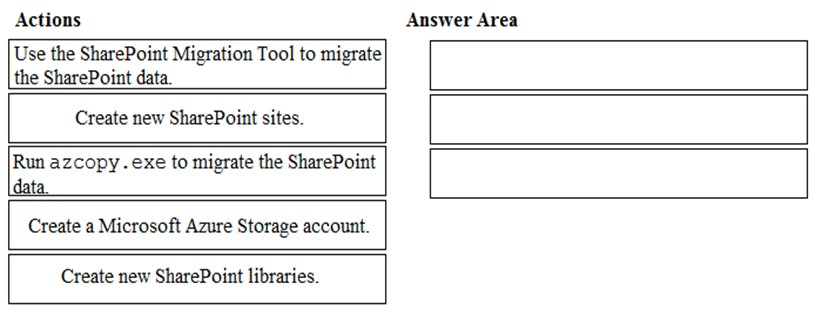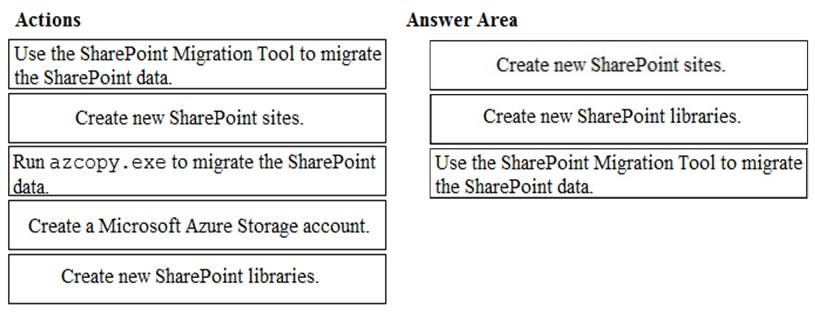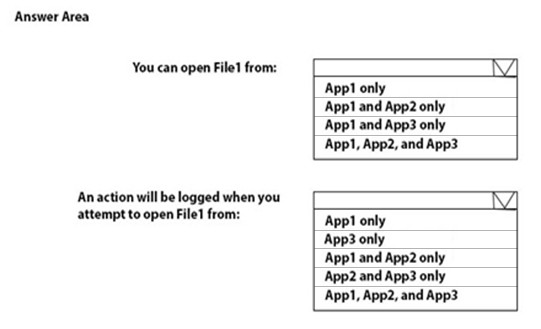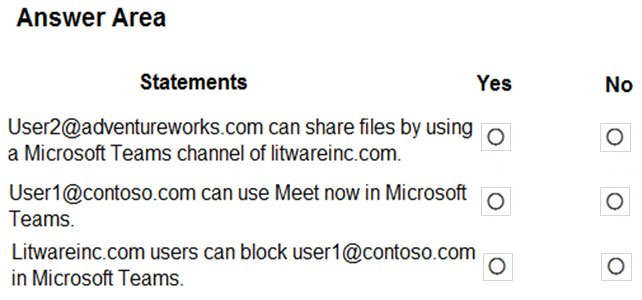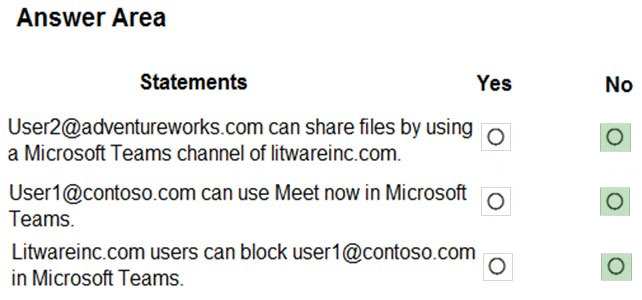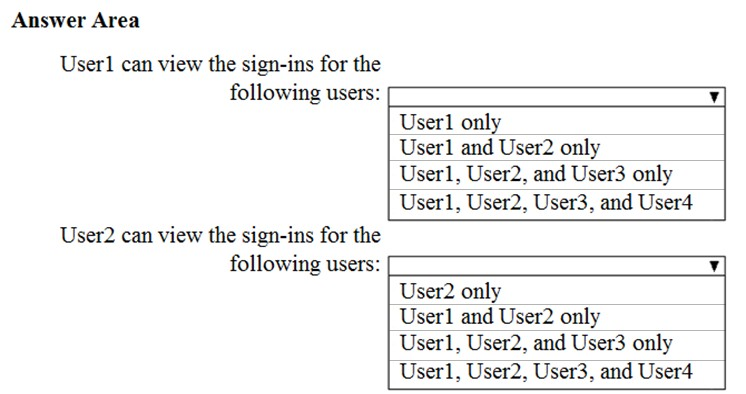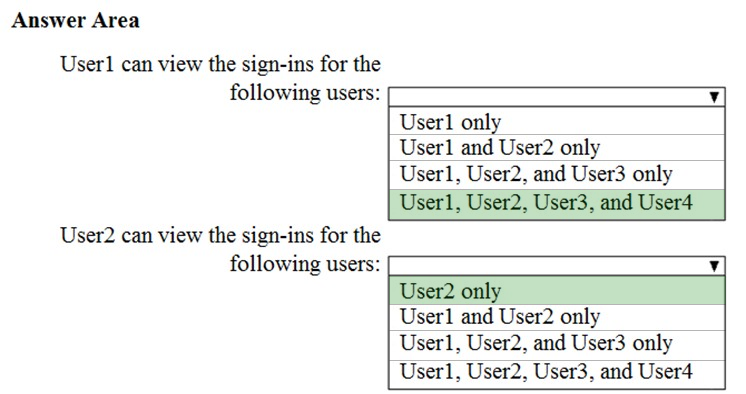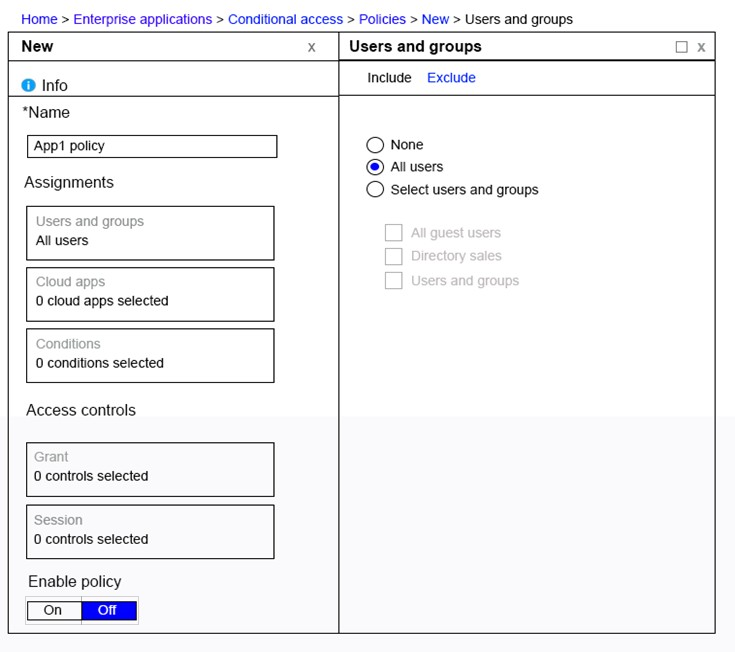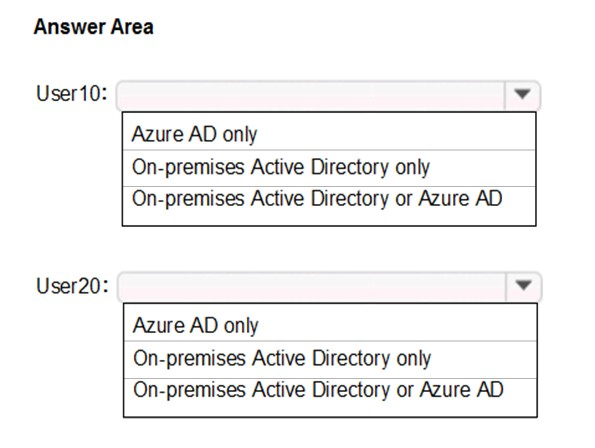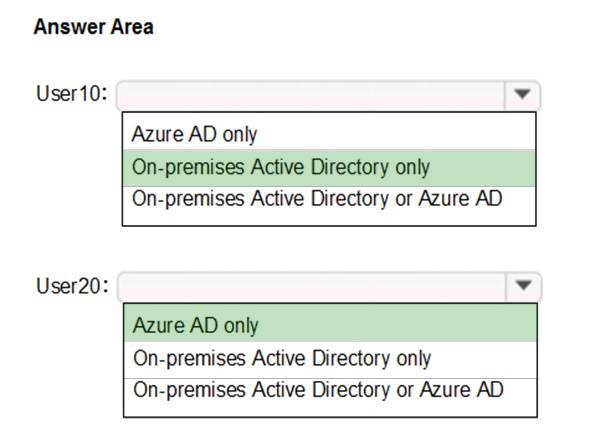MS-100 Practice Test Free – 50 Real Exam Questions to Boost Your Confidence
Preparing for the MS-100 exam? Start with our MS-100 Practice Test Free – a set of 50 high-quality, exam-style questions crafted to help you assess your knowledge and improve your chances of passing on the first try.
Taking a MS-100 practice test free is one of the smartest ways to:
- Get familiar with the real exam format and question types
- Evaluate your strengths and spot knowledge gaps
- Gain the confidence you need to succeed on exam day
Below, you will find 50 free MS-100 practice questions to help you prepare for the exam. These questions are designed to reflect the real exam structure and difficulty level. You can click on each Question to explore the details.
HOTSPOT - You have a Microsoft 365 E5 subscription. You create a Conditional Access policy named Policy1 and assign Policy1 to all users. You need to configure Policy 1 to enforce multi-factor authentication (MFA) if the user risk level is high. Which two settings should you configure in Policy1? To answer, select the appropriate settings in the answer area. NOTE: Each correct selection is worth one point.
You have a Microsoft 365 E5 subscription. All users are assigned a license to Microsoft 365 Apps for enterprise. The users report that they do not have the option to install Microsoft 365 apps on their device as shown in the following exhibit.You need to ensure that the users can install Microsoft 365 apps from the Office 365 portal. What should you do?
A. From the Microsoft 365 admin center, modify the user license settings.
B. From the Microsoft Endpoint Manager admin center, create a Microsoft 365 Apps app and assign the app to the devices.
C. From the Microsoft Endpoint Manager admin center, create a Microsoft 365 Apps app and assign the app to the users.
D. From the Microsoft 365 admin center, modify the Services settings.
DRAG DROP - You have several Microsoft SharePoint document libraries in your on-premises environment. You have a Microsoft 365 tenant that has directory synchronization implemented. You plan to move all the document libraries to SharePoint Online. You need to recommend a migration strategy for the document libraries. Which three actions should you recommend be performed in sequence? To answer, move the appropriate actions from the list of actions to the answer area and arrange them in the correct order. Select and Place:
You plan to deploy Microsoft Teams to 2,500 users. You need to estimate the internet bandwidth required for the deployment. What should you use?
A. Advisor for Teams
B. Network planner
C. Skype for Business Server Remote Connectivity Test
D. Microsoft Remote Connectivity Analyzer
Your on-premises network contains an Active Directory domain. You have a Microsoft 365 subscription. You need to sync the domain with the subscription. The solution must meet the following requirements: • On-premises Active Directory password complexity policies must be enforced. • Users must be able to use self-service password reset (SSPR) in Azure AD. What should you use?
A. Azure AD Seamless Single Sign-On (Azure AD Seamless SSO)
B. pass-through authentication
C. password hash synchronization
D. Azure AD Identity Protection
HOTSPOT - You have a Microsoft Azure Active Directory (Azure AD) tenant named contoso.com. You have three applications App1, App2, App3. The Apps use files that have the same file extensions. Your company uses Windows Information Protection (WIP). WIP has the following configurations: ✑ Windows Information Protection mode: Silent ✑ Protected apps: App1 ✑ Exempt apps: App2 From App1, you create a file named File1. What is the effect of the configurations? To answer, select the appropriate options in the answer area. Hot Area:
Your network contains an on-premises Active Directory domain named contoso.com. The domain contains 1,000 Windows 10 devices. You perform a proof of concept (PoC) deployment of Windows Defender Advanced Threat Protection (ATP) for 10 test devices. During the onboarding process, you configure Windows Defender ATP-related data to be stored in the United States. You plan to onboard all the devices to Windows Defender ATP data in Europe. What should you do first?
A. Create a workspace
B. Offboard the test devices
C. Delete the workspace
D. Onboard a new device
After you answer a question in this section, you will NOT be able to return to it. As a result, these questions will not appear in the review screen. Your company has 3,000 users. All the users are assigned Microsoft 365 E3 licenses. Some users are assigned licenses for all Microsoft 365 services. Other users are assigned licenses for only certain Microsoft 365 services. You need to determine whether a user named User1 is licensed for Exchange Online only. Solution: You run the Get-MsolUser cmdlet. Does this meet the goal?
A. Yes
B. No
You have an on-premises Microsoft Exchange Server organization that contains 100 mailboxes. You have a hybrid Microsoft 365 tenant. You run the Hybrid Configuration wizard and migrate the mailboxes to the tenant. You need to ensure that Microsoft 365 spam filtering is applied to incoming email. What should you do?
A. Run the Hybrid Configuration wizard again.
B. Update the Sender Policy Framework (SPF) TXT record to point to the on-premises Exchange IP address.
C. Run the Azure Active Directory Connect wizard again.
D. Update the MX record to point to Exchange Online.
Your company has 10 offices. The network contains an Active Directory domain named contoso.com. The domain contains 500 client computers. Each office is configured as a separate subnet. You discover that one of the offices has the following: ✑ Computers that have several preinstalled applications ✑ Computers that use nonstandard computer names ✑ Computers that have Windows 10 preinstalled ✑ Computers that are in a workgroup You must configure the computers to meet the following corporate requirements: ✑ All the computers must be joined to the domain. ✑ All the computers must have computer names that use a prefix of CONTOSO. ✑ All the computers must only have approved corporate applications installed. You need to recommend a solution to redeploy the computers. The solution must minimize the deployment time.
A. a provisioning package
B. wipe and load refresh
C. Windows Autopilot
D. an in-place upgrade
You work for a company manages all their identities in the cloud. After acquiring a new domain name, you are tasked with making sure that the primary email address of all new mailboxes uses the new domain. Which of the following is the Microsoft Exchange Online PowerShell cmdlet that you should run?
A. Update-EmailAddressPolicy
B. Update-OfflineAddressBook
C. Set-AddressBookPolicy
D. Set-EmailAddressPolicy
HOTSPOT - Your company has a Microsoft 365 tenant named litwareinc.com. The Guest access settings in Microsoft Teams are configured as shown in the following exhibit.The External access settings in Microsoft Teams are configured as shown in the following exhibit.
The company has a third-party supplier named adventureworks.com. Users in litwareinc.com collaborate with the following users by using Microsoft Teams: ✑ User1@contoso.com ✑ User2@adventureworks.com For each of the following statements, select Yes if the statement is true. Otherwise, select No. NOTE: Each correct selection is worth one point. Hot Area:
After you answer a question in this section, you will NOT be able to return to it. As a result, these questions will not appear in the review screen. Your network contains an on-premises Active Directory forest named contoso.com. The forest contains the following domains: ✑ Contoso.com ✑ East.contoso.com An Azure AD Connect server is deployed to contoso.com. Azure AD Connect syncs to an Azure Active Directory (Azure AD) tenant. You deploy a new domain named west.contoso.com to the forest. You need to ensure that west.contoso.com syncs to the Azure AD tenant. Solution: You install a new Azure AD Connect server in west.contoso.com and set AD Connect to active mode. Does this meet the goal?
A. Yes
B. No
HOTSPOT - You have a Microsoft 365 subscription that uses an Azure Active Directory (Azure AD) tenant named contoso.com. The tenant contains the users shown in the following table.From the Sign-ins blade of the Azure Active Directory admin center, for which users can User1 and User2 view the sign-ins? To answer, select the appropriate options in the answer area. NOTE: Each correct selection is worth one point. Hot Area:
You need to ensure that all the sales department users can authenticate successfully during Project1 and Project2. Which authentication strategy should you implement for the pilot projects?
A. password hash synchronization and seamless SSO
B. pass-through authentication
C. password hash synchronization
D. pass-through authentication and seamless SSO
You have a Microsoft 365 subscription. You recently configured a Microsoft SharePoint Online tenant in the subscription. You plan to create an alert policy. You need to ensure that an alert is generated only when malware is detected in more than five documents stored in SharePoint Online during a period of 10 minutes. What should you do first?
A. Enable Microsoft Office 365 Cloud App Security.
B. Deploy Windows Defender Advanced Threat Protection (Windows Defender ATP).
C. Enable Microsoft Office 365 Analytics.
After your company acquires a Microsoft 365 subscription, they instruct you to move all email data from their corporate Gmail to Microsoft Exchange Online. The migration will be done via the Exchange admin center. Which of the following is TRUE with regards to the data included in the migration?
A. All data will be migrated.
B. Only email data will be migrated.
C. Email and task data will be migrated.
D. Email and contact data will be migrated.
HOTSPOT - You have a Microsoft 365 Enterprise E5 subscription. You add a cloud-based app named App1 to the Microsoft Azure Active Directory (Azure AD) enterprise applications list. You need to ensure that two-step verification is enforced for all user accounts the next time they connect to App1. Which three settings should you configure from the policy? To answer, select the appropriate settings in the answer area. Hot Area:
HOTSPOT - You have a Microsoft 365 subscription. You use the Microsoft Office Deployment Tool to install Microsoft 365 Apps for enterprise. You create a configuration file that contains the following settings.Use the drop-down menus to select the answer choice that completes each statement based on the information presented in the graphic. NOTE: Each correct selection is worth one point. Hot Area:
HOTSPOT - You have a Microsoft 365 E5 subscription. Currently, users cannot install Microsoft 365 Apps for enterprise from the Microsoft Office portal. You need to perform the following tasks: • Enable the installation of Microsoft 365 Apps for enterprise from the Office portal. • Ensure that the users can auto-claim Microsoft Teams licenses. Which two Org settings should you configure in the Microsoft 365 admin center? To answer, select the appropriate settings in the answer area. NOTE: Each correct selection is worth one point.
A user receives the following message when attempting to sign in to https://myapps.microsoft.com: "Your sign-in was blocked. We've detected something unusual about this sign-in. For example, you might be signing in from a new location, device, or app. Before you can continue, we need to verify your identity. Please contact your admin." Which configuration prevents the users from signing in?
A. Security & Compliance supervision policies
B. Security & Compliance data loss prevention (DLP) policies
C. Microsoft Azure Active Directory (Azure AD) conditional access policies
D. Microsoft Azure Active Directory (Azure AD) Identity Protection policies
Your company has a Microsoft 365 subscription. You plan to move several archived PST files to Microsoft Exchange Online mailboxes. You need to create an import job for the PST files. Which three actions should you perform before you create the import job? Each correct answer presents part of the solution. NOTE: Each correct selection is worth one point.
A. Create a Microsoft Azure Storage account.
B. From the Microsoft 365 compliance center, retrieve the SAS key.
C. Run azcopy.exe to copy the PST files to Microsoft Azure Storage
D. From Exchange admin center, run a new migration batch.
E. Create a PST import mapping file.
You have a Microsoft 365 subscription. You plan to implement a hybrid configuration that has the following requirements: • Minimizes the number of times users are prompted for credentials when they access Microsoft 365 resources • Supports the use of Azure AD Identity Protection You need to configure Azure AD Connect to support the planned changes implementation. Which two options should you select? Each correct answer presents part of the solution. NOTE: Each correct selection is worth one point.
A. Pass-through authentication
B. Password writeback
C. Enable single sign-on
D. Password Hash Synchronization
E. Directory extension attribute sync
You have a Microsoft 365 subscription that contains a user named User1. User1 requires admin access to perform the following tasks: • Manage Microsoft Exchange Online settings. • Create Microsoft 365 groups. You need to ensure that User1 only has admin access for eight hours and requires approval before the role assignment takes place. What should you use?
A. Microsoft Entra Verified ID
B. Azure Active Directory (Azure AD) Identity Protection
C. Conditional Access
D. Azure Active Directory (Azure AD) Privileged Identity Management (PIM)
You have a Microsoft 365 tenant that contains Microsoft Exchange Online. You plan to enable calendar sharing with a partner organization named adatum.com. The partner organization also has a Microsoft 365 tenant. You need to ensure that the calendar of every user is available to the users in adatum.com immediately. What should you do?
A. From the Exchange admin center, create a sharing policy.
B. From the Exchange admin center, create a new organization relationship.
C. From the Microsoft 365 admin center, modify the Organization profile settings.
D. From the Microsoft 365 admin center, configure external site sharing.
Your network contains two on-premises Active Directory forests named contoso.com and fabrikam.com. Fabrikam.com contains one domain and five domain controllers. Contoso.com contains the domains shown in the following table.You need to sync all the users from both the forests to a single Azure Active Directory (Azure AD) tenant by using Azure AD Connect. What is the minimum number of Azure AD Connect sync servers required?
A. 1
B. 2
C. 3
D. 4
After you answer a question in this section, you will NOT be able to return to it. As a result, these questions will not appear in the review screen. Your network contains an on-premises Active Directory forest named contoso.com. The forest contains the following domains: ✑ Contoso.com ✑ East.contoso.com An Azure AD Connect server is deployed to contoso.com. Azure AD Connect syncs to an Azure Active Directory (Azure AD) tenant. You deploy a new domain named west.contoso.com to the forest. You need to ensure that west.contoso.com syncs to the Azure AD tenant. Solution: You install a new Azure AD Connect server in west.contoso.com and set AD Connect to staging mode. Does this meet the goal?
A. Yes
B. No
SIMULATION - Please wait while the virtual machine loads. Once loaded, you may proceed to the lab section. This may take a few minutes, and the wait time will not be deducted from your overall test time. When the Next button is available, click it to access the lab section. In this section, you will perform a set of tasks in a live environment. While most functionality will be available to you as it would be in a live environment, some functionality (e.g., copy and paste, ability to navigate to external websites) will not be possible by design. Scoring is based on the outcome of performing the tasks stated in the lab. In other words, it doesn't matter how you accomplish the task, if you successfully perform it, you will earn credit for that task. Labs are not timed separately, and this exam may have more than one lab that you must complete. You can use as much time as you would like to complete each lab. But, you should manage your time appropriately to ensure that you are able to complete the lab(s) and all other sections of the exam in the time provided. Please note that once you submit your work by clicking the Next button within a lab, you will NOT be able to return to the lab. You may now click next to proceed to the lab. Lab information - Use the following login credentials as needed: To enter your username, place your cursor in the Sign in box and click on the username below. To enter your password, place your cursor in the Enter password box and click on the password below. Microsoft 365 Username: admin@admin.onmicrosoft.com Microsoft 365 Password: xxxxxxxxxx If the Microsoft 365 portal does not load successfully in the browser, press CTRL-K to reload the portal in a new browser tab. The following information is for technical support purposes only: Lab Instance: 111111111 -You need to ensure that all the users in your organization are prompted to change their password every 180 days. To answer the question, sign in to the Microsoft 365 portal.
After you answer a question in this section, you will NOT be able to return to it. As a result, these questions will not appear in the review screen. Your company has 3,000 users. All the users are assigned Microsoft 365 E3 licenses. Some users are assigned licenses for all Microsoft 365 services. Other users are assigned licenses for only certain Microsoft 365 services. You need to determine whether a user named User1 is licensed for Exchange Online only. Solution: You launch the Azure portal, and then review the Licenses blade. Does this meet the goal?
A. Yes
B. No
You have Microsoft 365 E5 subscription that contains the groups shown in the following exhibit.You need to create an access review. For which groups can you create the access review?
A. Group1 and Group2 only
B. Group3 and Group4 only
C. Group1, Group2, and Group3 only
D. Group1, Group2, Group3, and Group5 only
E. Group1, Group2, Group3, Group4, and Group5
You implement Microsoft Azure Advanced Threat Protection (Azure ATP). You have an Azure ATP sensor configured as shown in the following exhibit. Updates -How long after the Azure ATP cloud service is updated will the sensor update?
A. 1 hour
B. 7 days
C. 48 hours
D. 12 hours
E. 72 hours
SIMULATION - Please wait while the virtual machine loads. Once loaded, you may proceed to the lab section. This may take a few minutes, and the wait time will not be deducted from your overall test time. When the Next button is available, click it to access the lab section. In this section, you will perform a set of tasks in a live environment. While most functionality will be available to you as it would be in a live environment, some functionality (e.g., copy and paste, ability to navigate to external websites) will not be possible by design. Scoring is based on the outcome of performing the tasks stated in the lab. In other words, it doesn't matter how you accomplish the task, if you successfully perform it, you will earn credit for that task. Labs are not timed separately, and this exam may have more than one lab that you must complete. You can use as much time as you would like to complete each lab. But, you should manage your time appropriately to ensure that you are able to complete the lab(s) and all other sections of the exam in the time provided. Please note that once you submit your work by clicking the Next button within a lab, you will NOT be able to return to the lab. You may now click next to proceed to the lab. Lab information - Use the following login credentials as needed: To enter your username, place your cursor in the Sign in box and click on the username below. To enter your password, place your cursor in the Enter password box and click on the password below. Microsoft 365 Username: admin@admin.onmicrosoft.com Microsoft 365 Password: xxxxxxxxxx If the Microsoft 365 portal does not load successfully in the browser, press CTRL-K to reload the portal in a new browser tab. The following information is for technical support purposes only: Lab Instance: 111111111 - You plan to provide an external user named fabrikamuser@fabrikam.com with access to several resources in your Microsoft 365 tenant. You need to ensure that the external user can be added to Office 365 groups.
HOTSPOT - You have a Microsoft 365 subscription that contains the users shown in the following table.You have the named locations shown in the following table.
You create a conditional access policy that has the following configurations: ✑ Users and groups: - Include: Group1 - Exclude: Group2 ✑ Cloud apps: Include all cloud apps ✑ Conditions: - Include: Any location - Exclude: Montreal ✑ Access control: Grant access, Require multi-factor authentication User1 is on the multi-factor authentication (MFA) blocked users list. For each of the following statements, select Yes if the statement is true. Otherwise, select No. NOTE: Each correct selection is worth one point. Hot Area:
SIMULATION - Please wait while the virtual machine loads. Once loaded, you may proceed to the lab section. This may take a few minutes, and the wait time will not be deducted from your overall test time. When the Next button is available, click it to access the lab section. In this section, you will perform a set of tasks in a live environment. While most functionality will be available to you as it would be in a live environment, some functionality (e.g., copy and paste, ability to navigate to external websites) will not be possible by design. Scoring is based on the outcome of performing the tasks stated in the lab. In other words, it doesn't matter how you accomplish the task, if you successfully perform it, you will earn credit for that task. Labs are not timed separately, and this exam may have more than one lab that you must complete. You can use as much time as you would like to complete each lab. But, you should manage your time appropriately to ensure that you are able to complete the lab(s) and all other sections of the exam in the time provided. Please note that once you submit your work by clicking the Next button within a lab, you will NOT be able to return to the lab. You may now click next to proceed to the lab. Lab information - Use the following login credentials as needed: To enter your username, place your cursor in the Sign in box and click on the username below. To enter your password, place your cursor in the Enter password box and click on the password below. Microsoft 365 Username: admin@admin.onmicrosoft.com Microsoft 365 Password: xxxxxxxxxx If the Microsoft 365 portal does not load successfully in the browser, press CTRL-K to reload the portal in a new browser tab. The following information is for technical support purposes only: Lab Instance: 111111111 -You need to create a SharePoint site named Project1. Users from your organization must be able to share content from the site to external users. To answer, sign in to the Microsoft 365 portal.
You have a Microsoft 365 tenant. You have a line-of-business application named App1 that users access by using the My Apps portal. After some recent security breaches, you implement a conditional access policy for App1 that uses Conditional Access App Control. You need to be alerted by email if impossible travel is detected for a user of App1. The solution must ensure that alerts are generated for App1 only. What should you do?
A. From Microsoft Cloud App Security, modify the impossible travel alert policy.
B. From Microsoft Cloud App Security, create a Cloud Discovery anomaly detection policy.
C. From the Azure Active Directory admin center, modify the conditional access policy.
D. From Microsoft Cloud App Security, create an app discovery policy.
Your network contains an on-premises Active Directory domain named contoso.com. The domain contains a Microsoft Exchange Server 2019 organization. You plan to sync the domain to Azure Active Directory (Azure AD) and to enable device writeback and group writeback. You need to identify which group types will sync from Azure AD. Which two group types should you identify? Each correct answer presents part of the solution. NOTE: Each correct selection is worth one point.
A. a Microsoft 365 group that uses the Assigned membership type
B. a security group that uses the Dynamic Device membership type
C. a Microsoft 365 group that uses the Dynamic User membership type
D. a security group that uses the Assigned membership type
E. a security group that uses the Dynamic User membership type
Your network contains an Active Directory forest named contoso.local. You have a Microsoft 365 subscription. You plan to implement a directory synchronization solution that will use password hash synchronization. From the Microsoft 365 admin center, you successfully verify the contoso.com domain name. You need to prepare the environment for the planned directory synchronization solution. What should you do first?
A. From the public DNS zone of contoso.com, add a new mail exchanger (MX) record.
B. From Active Directory Domains and Trusts, add contoso.com as a UPN suffix.
C. From the Microsoft 365 admin center, verify the contoso.local domain name.
D. From Active Directory Users and Computers, modify the UPN suffix for all users.
HOTSPOT - Your company has a Microsoft 365 subscription that contains the users shown in the following table.External collaboration settings have default configuration. You need to identify which users can perform the following administrative tasks: ✑ Modify the password protection policy. ✑ Create guest user accounts. Which users should you identify for each task? To answer, select the appropriate options in the answer area. NOTE: Each correct selection is worth one point. Hot Area:
After you answer a question in this section, you will NOT be able to return to it. As a result, these questions will not appear in the review screen. You have a Microsoft 365 subscription. You discover that some external users accessed content on a Microsoft SharePoint site. You modify the SharePoint sharing policy to prevent sharing outside your organization. You need to be notified if the SharePoint policy is modified in the future. Solution: From the SharePoint site, you create an alert. Does this meet the goal?
A. Yes
B. No
After you answer a question in this section, you will NOT be able to return to it. As a result, these questions will not appear in the review screen. Your network contains an on-premises Active Directory domain named contoso.com. The domain contains the users shown in the following table.The domain syncs to an Azure Active Directory (Azure AD) tenant named contoso.com as shown in the exhibit.
User2 fails to authenticate to Azure AD when signing in as user2@fabrikam.com . You need to ensure that User2 can access the resources in Azure AD. Solution: From the Azure Active Directory admin center, you add fabrikam.com as a custom domain. You instruct User2 to sign in as user2@fabrikam.com . Does this meet the goal?
A. Yes
B. No
HOTSPOT - Your network contains an on-premises Active Directory domain named contoso.com. Your company purchases a Microsoft 365 subscription and establishes a hybrid deployment of Azure Active Directory (Azure AD) by using password hash synchronization. Password writeback is disabled in Azure AD Connect. You create a new user named User10 on-premises and a new user named User20 in Azure AD. You need to identify where an administrator can reset the password of each new user. What should you identify? To answer, select the appropriate options in the answer area. NOTE: Each correct selection is worth one point. Hot Area:
You have a Microsoft 365 E5 subscription that uses Microsoft Teams. You need to deploy the Microsoft Power Platform Center of Excellence (CoE) solution to a Microsoft Dataverse for Teams environment. What should you do first?
A. From the Teams client add PowerApps.
B. From the Teams client import the CoE solution.
C. Create a new team.
D. Create a canvas app.
Your network contains an Active Directory domain. You have an Azure Active Directory (Azure AD) tenant that has Security defaults enabled. Azure AD Connect is configured for directory synchronization. Password hash synchronization and pass-through authentication are disabled. You need to enable Azure AD Identity Protection to detect leaked credentials. What should you do first?
A. From the Azure Active Directory admin center, disable Security defaults.
B. From Azure AD Connect, enable pass-through authentication.
C. From the Azure Active Directory admin center, configure verifiable credentials.
D. From Azure AD Connect, enable password hash synchronization.
You have a Microsoft 365 subscription. A new corporate security policy states that you must automatically send DLP incident reports to the users in the legal department. You need to schedule the email delivery of the reports. The solution must ensure that the reports are sent as frequently as possible. How frequently can you schedule the delivery of the reports?
A. hourly
B. monthly
C. weekly
D. daily
SIMULATION - Please wait while the virtual machine loads. Once loaded, you may proceed to the lab section. This may take a few minutes, and the wait time will not be deducted from your overall test time. When the Next button is available, click it to access the lab section. In this section, you will perform a set of tasks in a live environment. While most functionality will be available to you as it would be in a live environment, some functionality (e.g., copy and paste, ability to navigate to external websites) will not be possible by design. Scoring is based on the outcome of performing the tasks stated in the lab. In other words, it doesn't matter how you accomplish the task, if you successfully perform it, you will earn credit for that task. Labs are not timed separately, and this exam may have more than one lab that you must complete. You can use as much time as you would like to complete each lab. But, you should manage your time appropriately to ensure that you are able to complete the lab(s) and all other sections of the exam in the time provided. Please note that once you submit your work by clicking the Next button within a lab, you will NOT be able to return to the lab. You may now click next to proceed to the lab. Lab information - Use the following login credentials as needed: To enter your username, place your cursor in the Sign in box and click on the username below. To enter your password, place your cursor in the Enter password box and click on the password below. Microsoft 365 Username: admin@admin.onmicrosoft.com Microsoft 365 Password: xxxxxxxxxx If the Microsoft 365 portal does not load successfully in the browser, press CTRL-K to reload the portal in a new browser tab. The following information is for technical support purposes only: Lab Instance: 111111111 - A user named Johanna Lorenz recently left the company. A new employee named Ben Smith will handle the tasks of Johanna Lorenz. You need to create a user named Ben Smith. Ben Smith must be able to sign in to http://myapps.microsoft.com and open Microsoft Word Online.
Your company has an on-premises Microsoft Exchange Server 2016 organization and a Microsoft 365 Enterprise E5 subscription. You plan to migrate mailboxes and groups to Exchange Online. You start a new migration batch. Users report slow performance when they use the on-premises Exchange Server organization. You discover that the migration is causing the slow performance. You need to reduce the impact of the mailbox migration on the end-users. What should you do?
A. Create a mail flow rule.
B. Configure back pressure.
C. Modify the migration endpoint settings.
D. Create a throttling policy.
Your company has an Azure Active Directory (Azure AD) tenant named contoso.com that contains 10,000 users. The company has a Microsoft 365 subscription. You enable Azure Multi-Factor Authentication (MFA) for all the users in contoso.com. You run the following query. search "SigninLogs" | where ResultDescription == "User did not pass the MFA challenge." The query returns blank results. You need to ensure that the query returns the expected results. What should you do?
A. From the Azure Active Directory admin center, configure the diagnostics settings to archive logs to an Azure Storage account.
B. From the Security & Compliance admin center, turn on auditing.
C. From the Security & Compliance admin center, enable Office 365 Analytics.
D. From the Azure Active Directory admin center, configure the diagnostics settings to send logs to an Azure Log Analytics workspace.
Your company has a Microsoft Azure Active Directory (Azure AD) tenant with multi-factor authentication enabled. You have also configured the Allow users to submit fraud alerts, and the Block user when fraud is reported settings to ON. A tenant user has submitted a fraud alert for his account. Which of the following is the length of time that the user's account will automatically be blocked for?
A. 24 hours
B. 90 days
C. 1 month
D. 1 week
SIMULATION - Please wait while the virtual machine loads. Once loaded, you may proceed to the lab section. This may take a few minutes, and the wait time will not be deducted from your overall test time. When the Next button is available, click it to access the lab section. In this section, you will perform a set of tasks in a live environment. While most functionality will be available to you as it would be in a live environment, some functionality (e.g., copy and paste, ability to navigate to external websites) will not be possible by design. Scoring is based on the outcome of performing the tasks stated in the lab. In other words, it doesn't matter how you accomplish the task, if you successfully perform it, you will earn credit for that task. Labs are not timed separately, and this exam may have more than one lab that you must complete. You can use as much time as you would like to complete each lab. But, you should manage your time appropriately to ensure that you are able to complete the lab(s) and all other sections of the exam in the time provided. Please note that once you submit your work by clicking the Next button within a lab, you will NOT be able to return to the lab. You may now click next to proceed to the lab. Lab information - Use the following login credentials as needed: To enter your username, place your cursor in the Sign in box and click on the username below. To enter your password, place your cursor in the Enter password box and click on the password below. Microsoft 365 Username: admin@admin.onmicrosoft.com Microsoft 365 Password: xxxxxxxxxx If the Microsoft 365 portal does not load successfully in the browser, press CTRL-K to reload the portal in a new browser tab. The following information is for technical support purposes only: Lab Instance: 111111111 -You need to prevent all the users in your organization from sending an out of office reply to external users. To answer, sign in to the Microsoft 365 portal.
You have a Microsoft 365 E5 subscription. You need to ensure that users are prompted for multi-factor authentication (MFA) when they attempt to access Microsoft SharePoint Online resources. Users must NOT be prompted for MFA when they attempt to access other Microsoft 365 services. What should you do?
A. From the Microsoft Endpoint Manager admin center, create an app protection policy.
B. From the multi-factor authentication page, configure the users settings.
C. From the Azure Active Directory admin center, create a conditional access policy.
D. From the Cloud App Security admin center, create an app access policy.
Free Access Full MS-100 Practice Test Free Questions
If you’re looking for more MS-100 practice test free questions, click here to access the full MS-100 practice test.
We regularly update this page with new practice questions, so be sure to check back frequently.
Good luck with your MS-100 certification journey!




